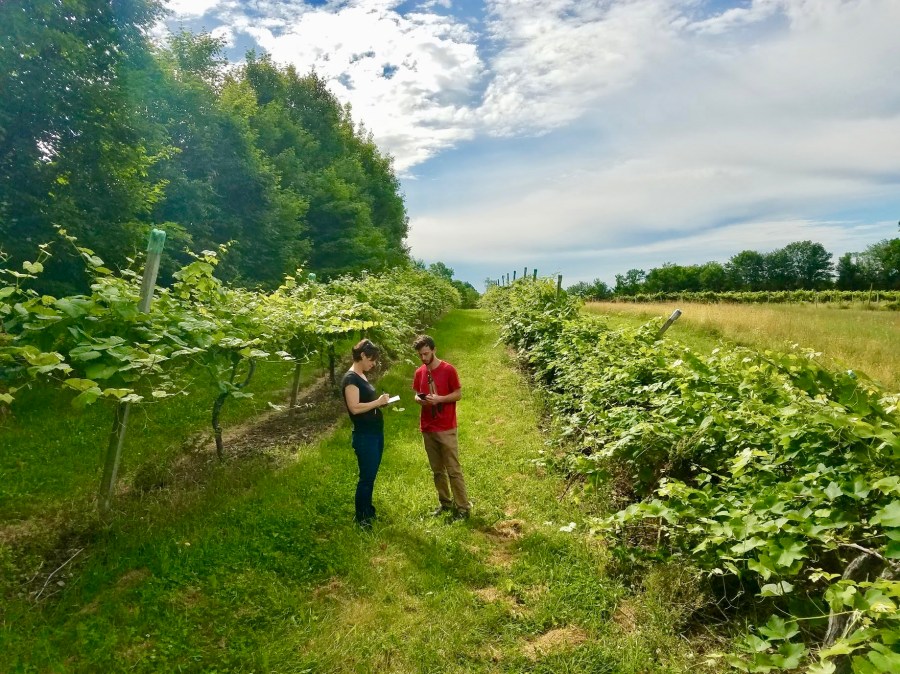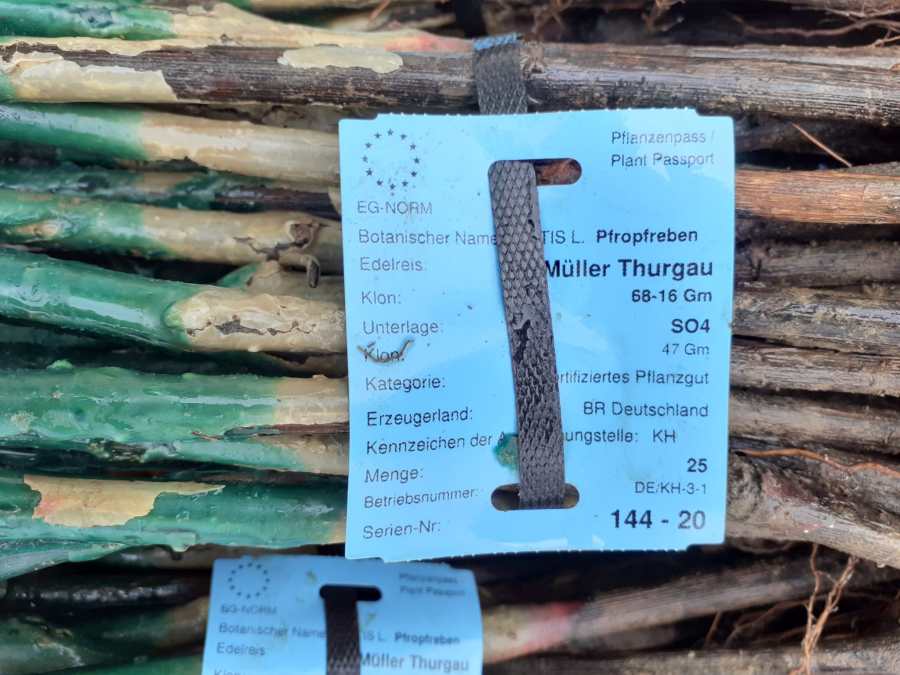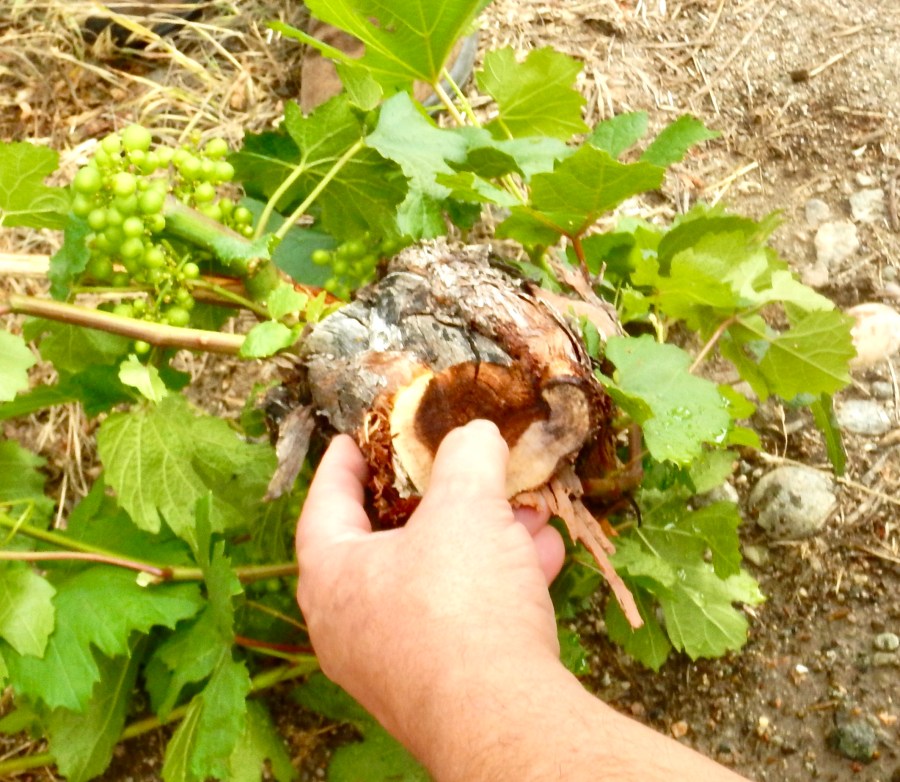The latest on grapevine trunk disease.
Grapevine Trunk Diseases (GTD) are a huge global problem. They can devastate a vineyard – leading to a decline in vine quality and lower yields through the loss of vigour or entire vines. GTDs are caused by a range of pathogenic fungi entering the vine through open wounds, normally pruning cuts.
This is a cyclical process, as spores on existing cankerous wood on old vines are re-dispersed by the elements, insects and even on pruning shears to infect new pruning wounds on young, healthy plants. The problem is compounded by the diseases being asymptomatic in the early stages, so by the time it is identified it may already be too late. The fungus will progressively kill the spurs, cordons and then trunks of the vine.
A family of diseases are caused by the GTD fungi, with nearly 100 species of pathogen having been identified as potential culprits causing damage to vineyards. It is unlikely that there will be a single ‘magic bullet’ found to treat such a complex problem, although research continues globally.
Three of the main GTDs
Esca (Black Measles)
Now believed to be in itself a family of diseases, esca appears on grapevines usually over five years old, although younger vines may already be infected. The first symptoms can include dark red or yellow stripes on leaves, depending on the cultivar, usually seen in the summer. They will eventually become necrotic.
The so-called “black goo” may also be present within the wood, causing brown staining. After cutting a cross-section of the trunk or spurs, a shiny tar-like substance may ooze from the wound instead of healthy clear sap. Black goo may be visible externally at the graft union. Upon further progression of the disease, the whole vine can die. Sometimes this can happen without any visible warning signs on the leaves.
Eutypa dieback
Caused by the Eutypa lata fungus. Diseased vines may present yellowed leaves, stunted shoots with dead edges and a distinctive cupped appearance. Cankerous dead wood will show the path of the infection through the vine. On the trunk, the bark will fall off to expose the stained brown wood. Grape bunches may ripen unevenly and have fewer, smaller berries. Where the infection is severe, the berries will not set at all. Infected grapevines will see a decline in productivity and eventually die.
Botrosphaeria dieback (formerly called bot canker)
Another fungal infection that mainly grows in mature wood, Botrosphaeria dieback is caused by fungi within the family Botryosphaeriaceae. The trunk may show wedge-shaped lesions when cut in cross-section, and ‘dead arm’ dieback can occur. Budburst may be delayed and infected shoots have a stunted appearance when they develop.
Practical measures to avoid infection
Guarding against the fungal spores that cause GTD is difficult, but some measures can be taken to decrease the likelihood of infection. For example, it is best to prune in dry conditions when spores are less likely to have been dispersed. Pruning late can also help, as the rising sap will help to displace spores on the cuts.
When pruning, the advice is to avoid larger wounds over 15mm when possible. If they must be made, use a wound paint or treatment to protect the area. Dispose of pruning waste to lower the risk of spore transfer, leading to the infection of young, healthy plants in the vineyard. Burning the prunings will lower but not eradicate the risk. Pulverising them may be the better option, leaving them to break down completely on healthy soil.
Breakthroughs in research
Recent research has is shedding new light on exactly how the families of GTD fungi cause damage. This mechanism has not previously been properly understood. The research is being undertaken by a group that includes Professor Barry Goodell, Professor of Microbiology at the University of Massachusetts. He has an extensive background in the fungal degradation of wood.
“Our research group has been developing an understanding of how certain fungi use very small molecules produced by the fungus (fungal metabolites) to bind, or chelate, metals like iron,” Professor Goodell told Vineyard Magazine. “Some types of fungal metabolite will change the state of iron molecules as part of the chelation process to make the iron very reactive. Once the iron is in this reactive state the fungi also generate oxygen radicals which react with that iron. This reaction (and oxygen radical reaction) causes extensive damage to wood cell walls. We call that damage “wood decay”.
“With the GTD work, we expanded our hypothesis of how the fungi cause wood to decay to also demonstrate that the fungi involved in GTD behaved similarly, and we demonstrated how the same types of oxygen radicals were produced in the GTD system.”
Professor Goodell has released a paper that illustrates how some types of antioxidants and chelators can be used to stop or inhibit the oxygen radical reaction. Antioxidants scavenge the oxygen radicals directly and remove them from the system. Meanwhile, some types of chelators can be added to the fungi to compete with the fungal metabolites and chelate iron that is being produced. This theoretically removes the reactive iron and stops or reduces the production of oxygen radicals.
It is not yet known how this treatment will work in practice. The group is hopeful that they can test it in the field in the future. They are open to working with UK research vineyards to try and find a practical way to combat GTDs.
“GTDs are already devastating, causing extensive damage to vineyards globally,” Professor Goodell observes. “They cost over a billion dollars each year in yield loss and for sanitation and vine replacement. Because GTDs tend to be more extensive in older vines, as vineyards mature the problem with GTDs is anticipated to grow.”

Goodell collaborator and student – Elsa Petit and Dana Sebestyen – University of Massachusetts Cold Spring Vineyard site in 2019
Keep it clean: nursery production processes and biosecurity
Planting a new vineyard and replenishing your stock through the generations depends on access to a quality stock of healthy young plants. Nursery production of grapevines for commercial supply requires the propagation and growth of new plants in a controlled environment until they are ready for transportation.
Nurseries need to have tight biosecurity measures in place to prevent the spread of pests and diseases that can have a significant impact on the health of the vines and the quality of their yield.
“To identify a reputable nursery for the supply of vines you need to trawl the network for the history of the nursery and get all the details of their plant passports for the production of the vines” explains independent agronomist John Buchan. “You want to know where the mother rootstocks come from and the procedure they are using for grafting.”
Plant Passports
The EU Plant Passport scheme is an official label for the sale of regulated plant material, which includes a phytosanitary certificate guaranteeing they are free of diseases such as fan leaf, xylella fastidiosa and trunk disease. Virus testing is controlled by the state in the country of origin. The original physical label will also give full details not just of the variety, clone and rootstock, but also of the grower. Anyone who deals with plants professionally needs to be registered with the UK plant health service. The plant passport system, which now has a UK equivalent, rests on two pillars; traceability and assurance.
In New Zealand, there is a Grafted Grape Standard that has been established and is overseen by New Zealand Winegrowers. They say it “seeks to provide assurance to growers, viticulturists, winemakers and other stakeholders and consumers, that certified grafted grapevines can be described as ‘high health’ vines.” As no similar model is in place in the UK, the onus falls on the grower to do their homework on any nursery they buy from to be assured that their stock has full traceability.

VineWorks buy vines from European nurseries who use an EU plant passport system that tie them to certain plant health rules and regulations. Using these ‘Blue’ passports allow for local plant health inspectors to issue Phytosanitary Certificates. The UK government use these Phyto Certificates to decide whether the plant product can be allowed within our borders. Once vines are in the UK their importer (VineWorks), will issue a new plant passport with the vines that adheres to our local system
Nursery production processes
Biosecurity doesn’t end with sourcing clean plant material. Nurseries must ensure that they work within a sanitary environment. Equipment, surfaces and the growing area must be cleaned regularly to reduce the risk of spreading pathogens. Grafting material may be stored in disinfectant.
Regular monitoring and testing for pests and diseases take place to make sure that any unexpected infection is caught early and not allowed to spread. Where so many young plants are being housed in close proximity, any contamination could have a devastating impact. For that reason, new plants or cuttings will be quarantined before being introduced to the main nursery, and controlled access and biosecurity protocols will be in place for visitors.
Rigorous sanitation protocols must also extend to the transportation of plant material, ensuring that everything is clean when vines are moved from their storage location to the end user.
Sunnybank Vines
Sarah Bell runs a small plant nursery of own root vines and bare wood cuttings for amateurs to grow. Sunnybank Vines is located in Herefordshire. They took over the National Collection of Vines in 2008, which contains over 450 cultivars. Many will be grubbed up in the coming season.
“The viniferas need a full spray programme to succeed,” Sarah explains. “That is no good for amateurs who don’t have access to the sprays, so they spread disease to the disease-resistant ones, so we don’t even get the grapes as a nice bi-product. There is no vine breeding in this country so the germplasm is not really of much value. The value was in trialling these vines for nearly 20 years – and identifying those that will do well for amateurs. This has been achieved.”
Sarah advocates buying from a reputable nursery or supplier when filling in gaps in a vineyard, emphasising the dangers of Grapevine Trunk Disease that spreads from rootstock to scion and is only apparent in about the third year after planting.
“Wine growers can use their own root cuttings or layering to replace lost vines,” Sarah says. “But you must be aware of plant breeders’ rights.” The PBR scheme in the UK recognises the intellectual property of plant breeders and developers. It offers protection against propagation for 25 years. Similar schemes exist in other countries around the world, although the length of the protection period can vary.
Many varieties commonly grown in UK vineyards have or have had protection under this scheme. The black grape Regent, for example, is a hybrid of Diana and Chambourcin. PBR was granted to the German government, represented by the Julius Kühn-Institut in 1996 and expires on 01/04/2024. The Institute has compiled the excellent Vitis International Variety Catalogue which is a mine of information on grapevines, their origins and their protections. (www.vivc.de)
Preparation for planting
Once you have sourced vines, they need to be given the best chance for success. “Soil preparation is key to establishment,” John Buchan says. “You must create a soil that is in an aerobic condition and make sure it has a good nutrient balance. It must be well-drained, and the site frost free. Preparation is the most important thing, do not try and short-change it.”
John is a passionate advocate for gathering as much information as possible about the type of soil you have, so that the nutrition of the vines can be best managed. A long soil analysis will give all the detail about the nutrition present and the composition. Knowing this will inform the selection of variety and rootstock, the density of planting and flag up any amendments that need to be made to provide the young plants with the optimum growing conditions.
“It takes a long time to establish a vineyard up to your first harvest,” John warns. “If you don’t get it right you’ll be chasing your tail forever.”




